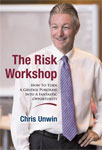CHRISISMS
A fortnightly pearl of wisdom to fast track your success
CHRISISM #35 - The Tunnel Analogy
21 February 2017
An analogy that was introduced to me a long time ago which I found quite useful at times was that the sales process is like standing at the beginning of a long tunnel with your prospect and, when you look down the tunnel, you can see a tiny circle of light at the end and all along the way there are doors on either side all of which are open. So the ‘aim of the game’ is to get to the end of the tunnel with your prospect so that, when you turn around and look back down the tunnel, all the doors are closed and your prospect has become a happy client.
Given the ‘aim of the game’ what some people will do is grab the prospect by the hand and drag them (sometimes kicking and screaming!) down the tunnel, slamming the doors closed as they go, and when they get to the end of the tunnel, they turn around with their prospect and say “There – done it!”. In what ways has this not achieved the desired result?
Firstly, you are the one who has dragged the prospect to the end of the tunnel rather than the prospect making the decision that they want to be there i.e. that they want to become a client.
In order to understand why this situation does not meet the necessary criteria, we need to understand what the open doors all the way along the tunnel represent. They represent potential escape routes for the prospect, so if they choose to exit out of one of these doorways, then they are choosing not to become a client. In the scenario outlined above, who has closed (or was it slammed?!) the doors along the way? It was you and not the prospect. The prospects must close the doors themselves or at the very least, if you close a door yourself, you need to seek their agreement to you closing that door.
Ideally, when you get to an open door, you should ask your prospect a question the answer to which will be them closing that door, but if you can’t think of an appropriate question, then you may also make a point or a statement that effectively closes that door in which case you need to check with your prospect that it’s ok with them that you have closed that door i.e. get their agreement or ‘buy-in’ to what you have said.
In terms of the types of questions that you should be asking, the ideal question is one to which there is only one legitimate answer, but you need to get the client to verbalise it e.g. “in the event of serious illness or accident, where between 0% and 100% would you want your income to be replaced?”. If such a question doesn’t spring to mind, then ask a question to which there could be more than one legitimate answer, any of which are fine by you e.g. “Would it be preferable for you to pay for this monthly, six monthly or annually?” This is often called an “alternative or tertiary close”.
If this analogy has resonated with you and helped you in some way, then make sure you come along to my upcoming “Client Acquisition & Engagement Skills” Workshop in your capital city in March, and I guarantee you will walk away with a host of simple, practical, usable client engagement tools that you can start using in your business right away, thereby enabling you to get an immediate return on your investment both of time and money. If you would like more information on these strategies and how to integrate them into your advice process as well as a bucketful of other “lightbulb moments” around your client engagement skills, then you need to come along to my Client Acquisition & Engagement Skills Workshop in your capital city in March. For details, click on the link below. Click here for my March Workshop details!
|





